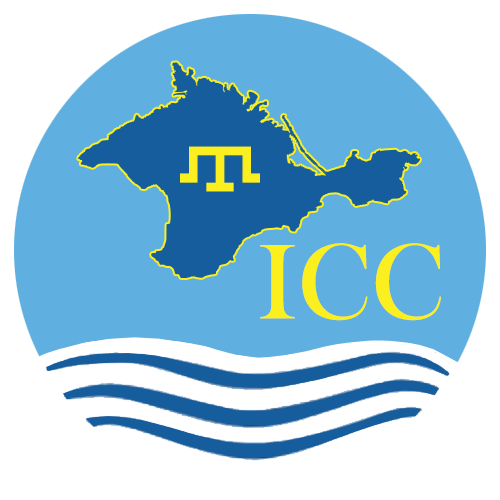
International Committee for Crimea
Making of a Crimean Tatar Human Rights Advocate:
An Interview with Mubeyyin Batu Altan*
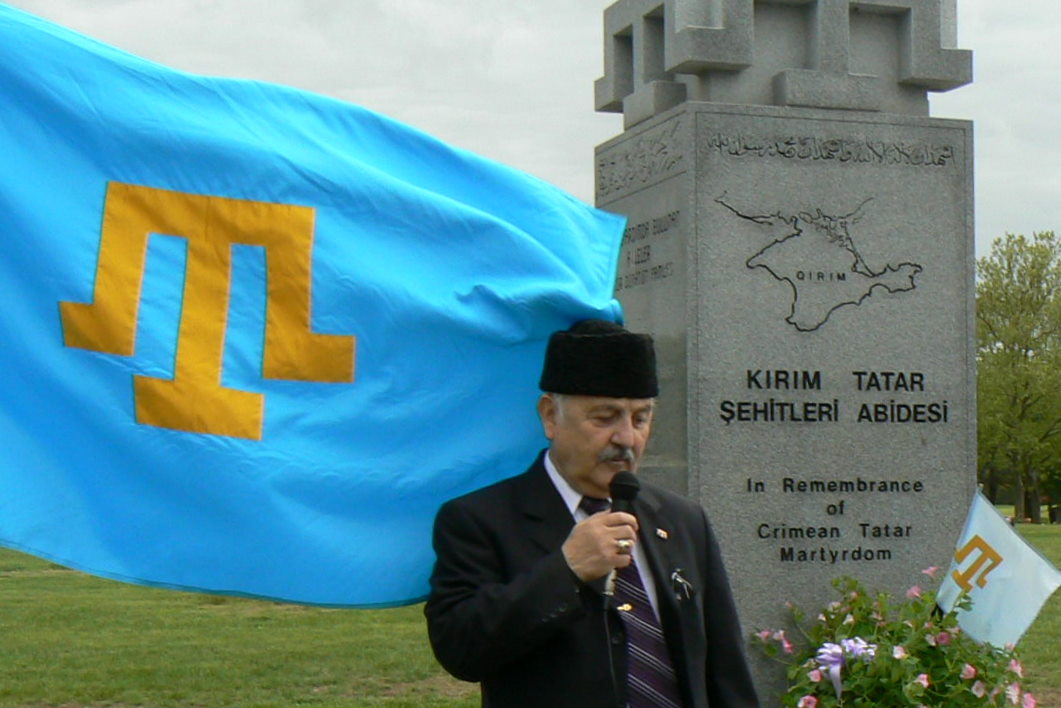
|
Mubeyyin Altan at Crimean Tatar Martyrs Monument |
Question: Thank you for agreeing to give this interview. Let us begin with very basic questions: Where were you born and what are some of your first childhood memories?
I was born in the town of Kulcora (Nekrosovka) in Icki (Sovietski) region. Icki region is considered to be Çöl (desert) area, the inner part of Crimea. My parents were from the Sudak region near the shores of the Black Sea (Yaliboylu), but had to relocate to Kulcora due to life threatening pressure from local communists.
Unfortunately I have no childhood memories of Crimea as our entire family was forced to leave Crimea when I was only forty days old. The first six years of my life were spent as DP (displaced person) moving from one place to another seeking a safer place to live and to survive. Most of my childhood memories are from the refugee camps in Germany and from Eskisehir, Turkey, where spent my childhood.
Question: When you were growing up, who else was in your family? And, their names?
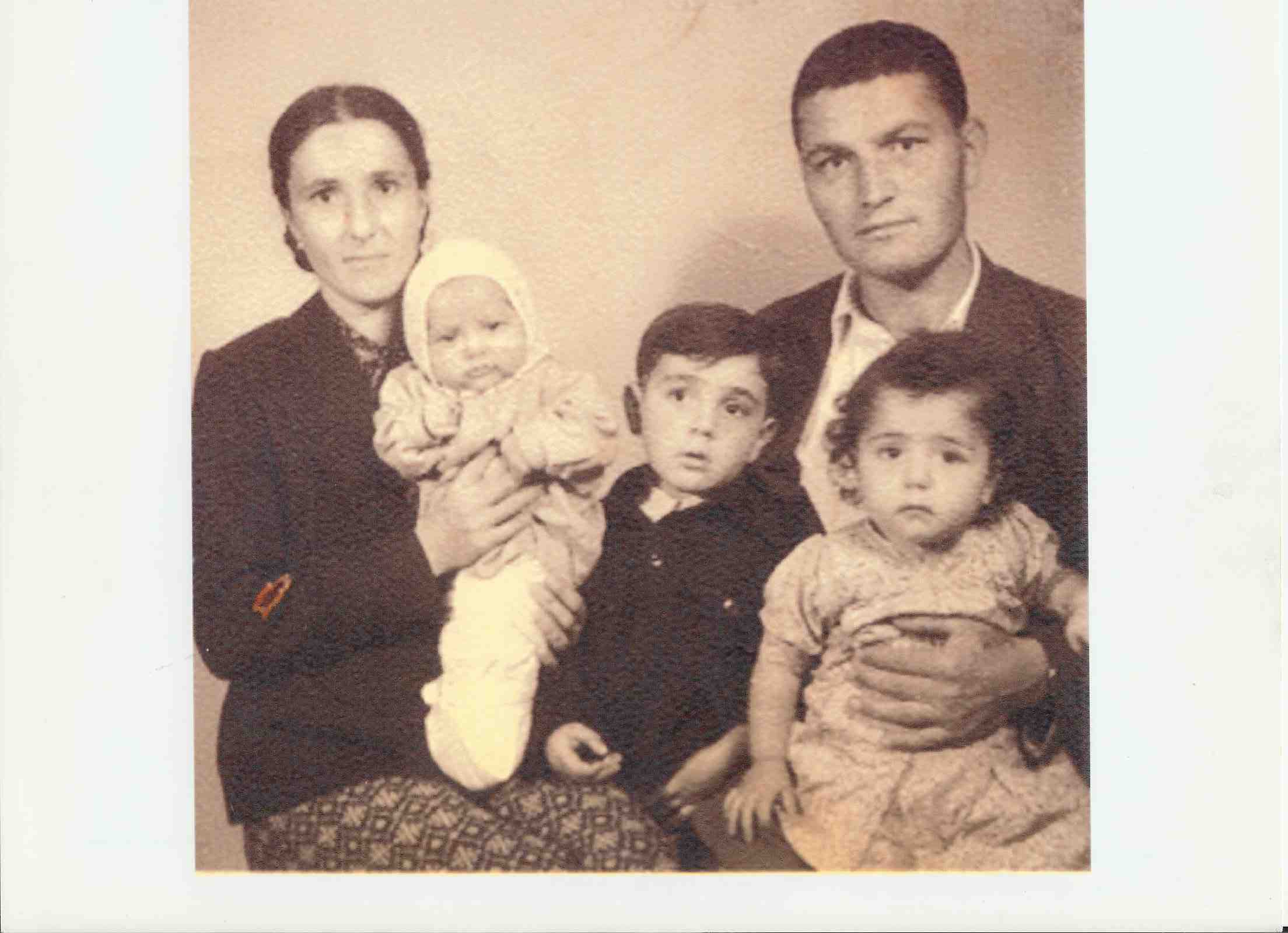
|
Mubeyyin's family at a refugee camp |
My immediate family consisted of my father Ibrahim, my mother Maksude, my sister Hatice, and my brother Mustafa. (My youngest brother Metin was later born in the USA.) Our last name then was Muhtar, my paternal grandfather's name which was changed when we immigrated to Turkey with the assistance of IRO (International Refugee Organization) of the United Nations. Like most Crimean Tatar refugees (Multeciler) we had temporarily settled in Tuzla Refugee Camps near Istanbul, and from there we were sent to the village of Bicer in Eskisehir, Turkey. No one from my mother's side was able to leave Crimea with us. The Muhtar family, my paternal grandmother Meryem, my oldest uncle Ismail's family (wife and two children), my youngest uncle Ali, my aunt Hanife and her family followed our family to Bicer, Eskisehir. My uncles were assigned to different cities in Turkey. Considering the horrors of war they had just experienced which left many of the family members behind, my grandmother did not want the family to be separated again and asked everyone to be together in Eskisehir. Despite our substandard living condition as newcomers and refugees, Eskisehir played an important part in my life where I grew up and went to school.
Question: So, you went to primary school in Eskisehir? Did any of your teachers have a particular influence on you?
Yes, I attended Yunus Emre Ilk Okulu in Eskisehir. In those years one had the same teacher for the entire five years of elementary education. My teacher was Nezir Sayin Bey who was musically oriented and played the violin which had impressed me. I must tell you about my first day at school which was a traumatic experience I still remember to this day. When I entered the class I started to cry as I did not speak Turkish and had difficulty understanding what was said to me. I adopted well shortly but never lost my multeci identity and had wonderful five years and graduated with excellent marks.
Question: Did you also go to high school in Eskisehir? Any particular hobbies, influential individuals during this period?
I attended middle school and high school at Eskisehir Ataturk Lisesi. Attending school in Germany for six months, and knowing some German from refugee camps influenced me to select German as my foreign language in middle and high school. I was interested in studying German, hoping to go to Germany to attend university there. I was also interested in collecting stamps and postcards of foreign countries.
My family life had a significant influence in my middle and high school years. At home I was a Crimean Tatar refugee, listening to stories about Crimea, the loved ones we left behind, and stories of our lives in the refugee camps perhaps subconsciously influenced my Weltanschauung. Outside our home I tried to adapt to my new social environment.
Question: Where did you go to college? Any influential teachers or fellow students during your graduate education?
We moved to the United States in the early 1960s and settled in New York. I attended University of Bridgeport in Bridgeport, Connecticut, both for my undergraduate and graduate studies, majoring in political science. I began my university studies with very limited English as I had studied German in high school. Professor Justus M. van der Kroef, the chairman of the Political Science department was the most influential teacher. Professor van der Kroef was a specialist on Indonesia with numerous books and articles written on Indenonesia and International politics.
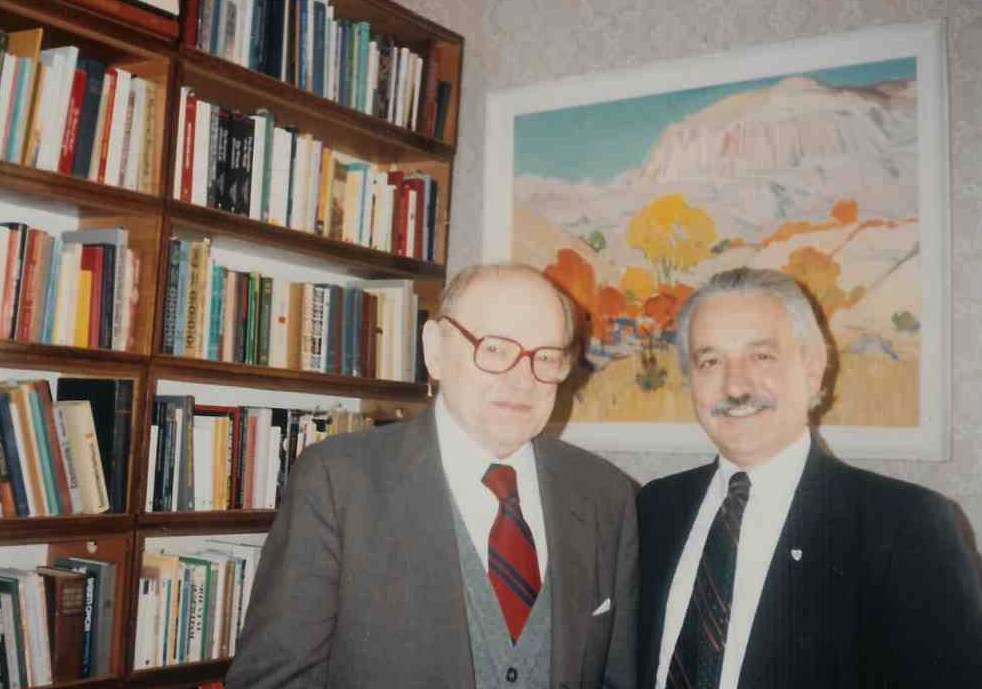
|
Omeljian Pritsak and Mubeyyin Altan, 1996 |
I also attended Harvard University and studied at Inner Asian and Altaic Studies Department, where I met Professor Omeljian Pritsak, a world renowned Ukrainian historian who was also a world renowned Turkologist and Orientalist. Unfortunately Professor Pritsak retired shortly after I met him. His goal was to reestablish the Institute of Oriental Studies in Kiev, Ukraine. Professor Pritsak successfully reestablished the Institute of Oriental Studies and invited me to be his assistant and study at the Institute of Oriental Studies. He became my advisor at the Institute where I had first selected "Togai Bei," a 17th century Crimean Tatar epic poem written by two different Crimean Tatar poets, Can Muhammad and Edip Efendi. I took two months of leave of absence and traveled to Kiev and Crimea to search for Can Muhammad's "Togai Bei." In 1925 an original copy of this epic poem had been given by my great grandfather Haci Ali Efendi of Kapsixor, the first chairman of the historic First Crimean Tatar Kurultay of 1917, to our national poet Eshref Semizade and his friends who were then traveling throughout Crimea collecting Crimean Tatar artifacts. Unfortunately, my search was unsuccessful and upon Professor Pritsak's recommendation, I began my research on 20th Century Crimean Tatar Emigrations, an oral history project I am still working on.
Question: Can you summarize your political activism during the period prior to the return of Crimean Tatars to their homeland?
Before answering this question I should briefly answer why I am so deeply involved in the Crimean Tatar national struggle, as I am asked this question frequently.
Simply put, I was born into the Crimean Tatar tragedy and my interest in the tragic experience of my people occupied my entire life to this day. My family spent many years in different refugee camps following World War II, and this had an enormous influence on me and practically shaped my Weltanschauung since my childhood. Crimea and Crimean Tatars were the subjects frequently discussed during family gatherings. When we lived in Eskisehir, the multeci (refugee) families frequently visited each other to reminisce the good and bad old days. Their conversations mostly focused on their beautiful Crimean homeland and the loved ones they left behind. I have dedicated my life to Crimean Tatar cause early on in my life. Watching my tearful parents, especially my mother who was only seventeen years old when we were forced to leave Crimea and had no one from her family with her, had left an everlasting impression on me and made me question why we were subjected to this terrible experience. I decided to make it my mission (if I ever had a chance) to tell the world what my family and my people have experienced; I pledged to tell our story.
I consider myself a "Crimean Tatar Human Rights Advocate" campaigning for the restoration of our people's blatantly violated human and national rights. I wrote my senior graduation paper as well as my Master's Thesis at the University of Bridgeport on the plight of Crimean Tatars, when hardly anyone knew or even cared about them. Even though source material on Crimean Tatars at the time was quite limited, I would not consider any other topic as I felt obligated to inform my classmates and my university on this subject as best as I could.
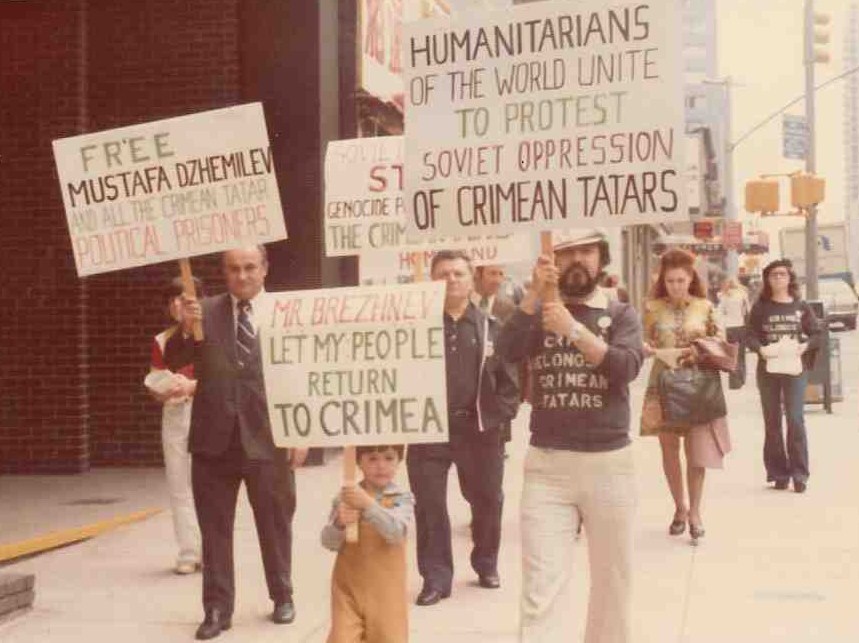
|
Mubeyyin Altan at a demonstration in NY, 1975 |
The turning point of my political activism came with the Dissident Movement in the Soviet Union, which generated much needed coverage not only by the American mass media, but also the world media. I was closely following the Soviet Dissident Movement and the political changes occurring in the Soviet Union with Crimean Tatars in mind. I distinctly remember the day when the Decree of September 5, 1967, was promulgated by the Soviet government partially exonerating the Crimean Tatars. I'll always remember the night when I read about this historic news with great excitement, and ran home with my brother, calling family and friends to spread the good news. I became more involved with the dissident movement, and met with some of the well known dissidents such as Pavel Litvinov, Andrei Amalrik, Valeri Chalidze and others. I also met General Piotr G. Grigorenko and his family, as well as Dr.Andrei Sakharov. I was with General Grigorenko at Harvard University on that day the Soviet government revoked his Soviet citizenship. I was also the Crimean Tatar representative delivering a eulogy and spreading a handful of Crimean soil on his grave when he passed away. In the early 1970s, I was elected to the Executive Committee of the American Association of Crimean Turks, Inc. located in Brooklyn, New York. This new Executive Committee was very much interested in assisting our compatriots in Uzbekistan in any way possible. However, our community refused to get involved with our people's struggle in the Soviet Union for various reasons. In 1976, the late Mehmet Sevdiyar, a historian and journalist; Fikret Yurter, a Mechanical Engineer; and I were forced to established the Crimea Foundation in order focus on the political activities of our compatriots in Uzbekistan especially with the Crimean Tatar National Movement. We had earlier established contact with the members of the "Movement" and were receiving very critical documents through special channels. Crimea Foundation published several books and was also instrumental in the publication of the Tashkentskii Protsess, one of the most comprehensive books regarding the Crimean Tatar National Movement. I had traveled to London to take some Crimean Tatar documents to Professor Peter Reddaway who was then the editor of the Chronicle of Current Events. Professor Reddaway, also board member of the Herzen Foundation, had informed me about Herzen Foundation's work on the Taskentskii Protsess. Upon my return to New York, I informed our group about this important project and the Crimea Foundation decided to get involved in this historic work. I consider the publication of this book as one of our significant accomplishments that I will always be proud of.
My political activities intensified with the publication of the Taskentskii Protsess in 1976. As we learned more about the Crimean Tatar National Movement it became imperative to inform the American as well as the world public about the plight of the Crimean Tatar people without worrying about jeopardizing the lives our compatriots. And, that is what we did. As the English speaking member of the Crimea Foundation (Mehmet Sevdiyar aga handled the Russian-related issues and Fikret Yurter aga the German-related issues and documents), I went to high schools, universities, and ethnic gatherings to lecture on the subject, or wherever we were invited to present our people's case. I even went to middle schools to talk about Crimean Tatars.
Question: Any other publications during this period that you consider important?
I always felt, however, that with my political activities I was able to reach only to a limited audience. I needed to expand and reach larger audiences to inform them about one of the most blatant violations of human rights perpetrated against a small Turkic-Muslim people hardly anyone knew about. That is why after discussing it with my wife Lemis, I decided to publish the Crimean Review, the first English language magazine on the Crimean Tatar National Movement. The first issue of the Crimean Review was ready to be mailed on May 18, 1986, and symbolically I mailed the copies from the historic Concord, Massachusetts. I was the owner, the editor in chief, author of many of the articles, and my wife Lemis was the technical advisor. We spent lots of time, sweat and tear in trying to publish this journal. Like all my political activities, the entire publication of the Crimean Review was totally financed by me, I had no sponsors. I had to balance my time for my political activities with the time for my full time job and the time for the family. It was one of the most difficult but rewarding times of my and my wife's lives. But judging from requests and letters we received from all around the world, I could say without hesitation that we succeeded in reaching a much larger audience to inform them about the plight of the Crimean Tatar people.
The bi-annually published Crimean Review lasted until 1995 when Internet became a more popular way to reach a larger audience. Through the Crimean Review, I was able to reach a worldwide audience as I received many request regarding information about the Crimean Tatars; requests came from academics, graduate students and ordinary citizens from England, Poland, Italy, France, Germany, Malaysia, Canada and Turkey as well as from the United States. I spent a great deal of time attending conferences to present the plight of my people as well as responding to requests of academics for information and documents as well as graduate students who were writing their master or doctoral thesis.
I consider the Crimean Review, the first and only English language human rights journal of the Crimean Tatar national struggle as my contribution to our national cause. As the editor and owner of the Crimean Review I published it in the "pre-internet" era under very difficult conditions. I have no special plan to resume publishing it at this time.
Question: When did you first meet Mustafa Jemilev?
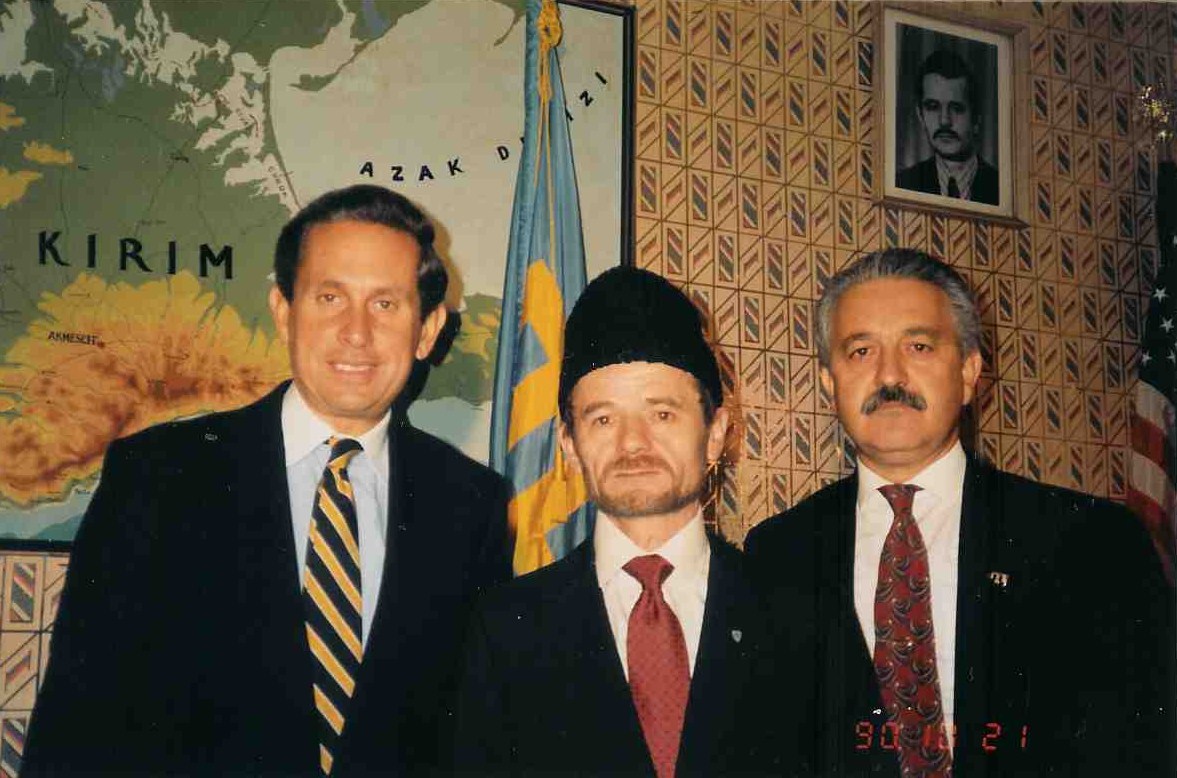
|
Congressman Stephen Solarz, Mustafa Jemilev |
I had been following Mustafa Jemilev's and all the Soviet dissident activities since the early days of the Movement. I was one of the speakers in a conference sponsored by the Mustafa Jemilev Defense Committee on June 24, 1976. I also had the opportunity to talk to him via phone when he was incarcerated in Magadan in 1986.
Personally, I first met him in 1990 when he was invited by the American Association of Crimean Turks, Inc. in Brooklyn NY. I invited Mustafa Jemilev and Iskender Fazil, the late Crimean Tatar poet, to Massachusetts where I was residing at the time. We visited Harvard University, met Professor Alexander M. Nekrich, an eyewitness to the Crimean Tatar Surgun (mass deportation) and the author of The Punished People (1978). Mustafa Jemilev, Iskender Fazil and I had long and interesting discussions about the future of the Crimean Tatar people during this visit. It is interesting that our first meeting was about a year before the historic second Crimean Tatar Kurultay which elected him as the chairman of Mejlis.
Question: You have done considerable research on Crimean Tatar emigrations. Can you summarize your research activities?
My research topic is "20th Century Crimean Tatar Emigrations from Crimea to Turkey- Emigrations of the 1930s and 1940s." I am interested in those Crimean Tatars who personally participated in these two different emigrations. Professor Pritsak and I discussed and agreed that the number of such Crimean Tatars would be limited, and should try to interview as many of them as I could.
I began my interviews in New York, then traveled to various cities where these Crimean Tatars lived. I traveled to Eskisehir, Ankara, Istanbul and located as many of my subjects as possible. In Eskisehir I discovered that Hamza Goktay Bey kept a special record of Crimean Tatar multecis (refugees) who were in different refugee camps in several different European countries.
Several of my articles on this subject are already published, and I participated in several conferences to present this topic. Unfortunately the passing of my mother who was my inspiration and some health issues significantly curtailed my work and motivation. I am currently working on the interviews of Crimean Tatars who actually took part in these emigrations. There were a few of these special people to begin with and they are disappearing fast. This makes my search for such Crimean Tatars more difficult.
I must reiterate the limitations I had doing this research which I tried to conduct on my days off from my full time work, on my vacation as well as special short leaves I could manage. My research is now a book project, on which I am planning to spend more time.
Question: Any other projects you are currently working on?
I have a collection of oil paintings by a renowned Crimean Tatar painter Seitxalil Osmanov depicting the mass deportation, Surgun, of our people. The late Seitxalil Aga, who was also a well known actor, created some of these Surgun paintings especially for me for the purpose of disseminating the Crimean Tatar people's tragedy to the world public. One of my special projects is to find a permanent place for these paintings and my Crimean Tatar books and documents to be properly exhibited where public can be informed and educated about the Crimean Tatar Tragedy (Kirim Tatar Faciasi).
Also, I am in the early stage of collecting into one volume my various writings and speeches given before the three different Congresses (Kurultays) in Crimea. In addition, I have several projects related to the history of the Crimean Tatar community in New York.
Question: How did you get involved in the International Committee for Crimea (ICC)?
I was involved in the founding of the ICC from the beginning. That is, I was not a late comer to the ICC. Prior to the founding of the ICC, I was sending my articles on Crimean Tatars to Turkistan-L. In fact, I was invited to join Turkistan-L by Dr. Hasan Paksoy and became a member of its editorial board. It was at that time that the urgent need for our own forum strictly dealing with the Crimean Tatar issues surfaced. I and four or five other members of Turkistan-L had launched a discussion to name this new forum. I distinctly remember supporting the name "ICCrimea" and voting for it as I would always read "ICCrimea" as I See Crimea! If my memory serves me correctly Idil N. Izmirli and I were the first co-chairs of the ICC.
In my entire life as a Crimean Tatar political activist, my major goal has been to disseminate as much information related to the plight of the Crimean Tatar people as possible. With my aforementioned political activities I was able to reach only a limited audience. Given the importance of the ongoing plight of the Crimean Tatars it was important to reach a larger audience.
As the first President of the ICC, I believe, I had this opportunity to reach a larger audience to inform and educate not only the American public but the World Public as well. I attempted to accomplish this with my articles and my written commentaries as well as special statements related to historic events during my tenure as President of the ICC.
Question: As one of the well known Crimean Tatar activists, what do you think the future holds for Crimea? What should be done?
We must briefly summarize the current status of the Crimean Tatars before answering this question.
It is unfortunate that after sixty seven years of their unjust, brutal and inhuman mass deportation from their homeland by the USSR, the indigenous people of Crimea, the Crimean Tatars, still remain a divided nation. Almost half the deported Crimean Tatar people are still forced to remain in their original places of exile, mostly in Uzbekistan. Of course, there have been some improvements in the lives of the Crimean Tatar people if we compare their current status to their status right after the historic Decree of September 5, 1967. In the early days, the mere existence of such people as Crimean Tatars was denied by the Soviet authorities and those who dared to return to Crimea and resettle there per the 1967 Decree were brutally re-deported because the authorities made it clear to those courageous returnees that "Crimea is not for Crimean Tatars."
The status of "returnees" has improved thanks to the active political pressure put on the local Crimean authorities by the Crimean Tatar people. Crimean Tatars are politically better organized under the Crimean Tatar National Mejlis. There is one Crimean Tatar Deputy, Mustafa Jemilev, in the Ukrainian Parliament and four Crimean Tatar deputies in the Crimean parliament. But the fact remains that Crimean Tatar people's political, economic and social status is still not fully restored. The Crimean Tatar National Mejlis as the elected representative of the Crimean Tatar people continues and will continue to fight against the Ukrainian National and Crimean local authorities for political acceptance as long as both the Ukrainian and Crimean authorities lack the "Political Will" to resolve the Crimean Tatar problem. they must genuinely accept the Tatar people as the indigenous people of Crimea.
I am optimistic about the Crimean Tatars' future if the Crimean Tatar National Mejlis and the Crimean Tatar people continue to have the "National Spirit" (Milli Ruh) to resist and fight the ongoing political, social and economic injustices implemented by the Ukrainian and Crimean authorities to stop Crimean Tatars' resettlement in their ancestral homeland.
I would like to see the younger generation of Crimean Tatars given more opportunities to participate in the Crimean Tatar National Kurultay and given more political responsibilities as members of Crimean Tatar National Mejlis. I would like to see the Mejlis taking the issue of the Crimean Tatar Territorial Autonomy more seriously. I would like to see the blue print of this autonomy, and see this program accepted as the main item on the next Crimean Tatar National Kurultay. Without autonomy, without the capacity to determine our own destiny, I am afraid, the Crimean Tatars will continue to struggle against the national and local authorities who lack the political will to treat Crimean Tatars as people and a nation.
I would like to see the Crimean Tatar Mejlis revisit the resolutions related to the future of the Crimean Tatar people adopted by the historic Second Crimean Tatar Kurultay of June 26-30, 1991. I would also like to see the Mejlis mobilize the Crimean Tatar people to fight for the full restoration of their human and national rights with the same determination and intensity they possessed during the Soviet period.
I am glad to see that the Mejlis finally decided to carry the plight of the Crimean Tatar people to an international platform. This will definitely put pressure on Ukraine as well as on Crimean authorities to pay serious attention to the decade-long Crimean Tatar problem.
Last but not least, I would like to see a large number of Crimean Tatars led by Mejlis hold the next May 18 Commemoration Day in Kiev in front of the Ukrainian Parliament, which would also draw the world's attention to one of the political hot spots in the region.
Question: We understand why you remain so dedicated to the cause of Crimean Tatars. But what has given you the strength to continue on this arduous path?
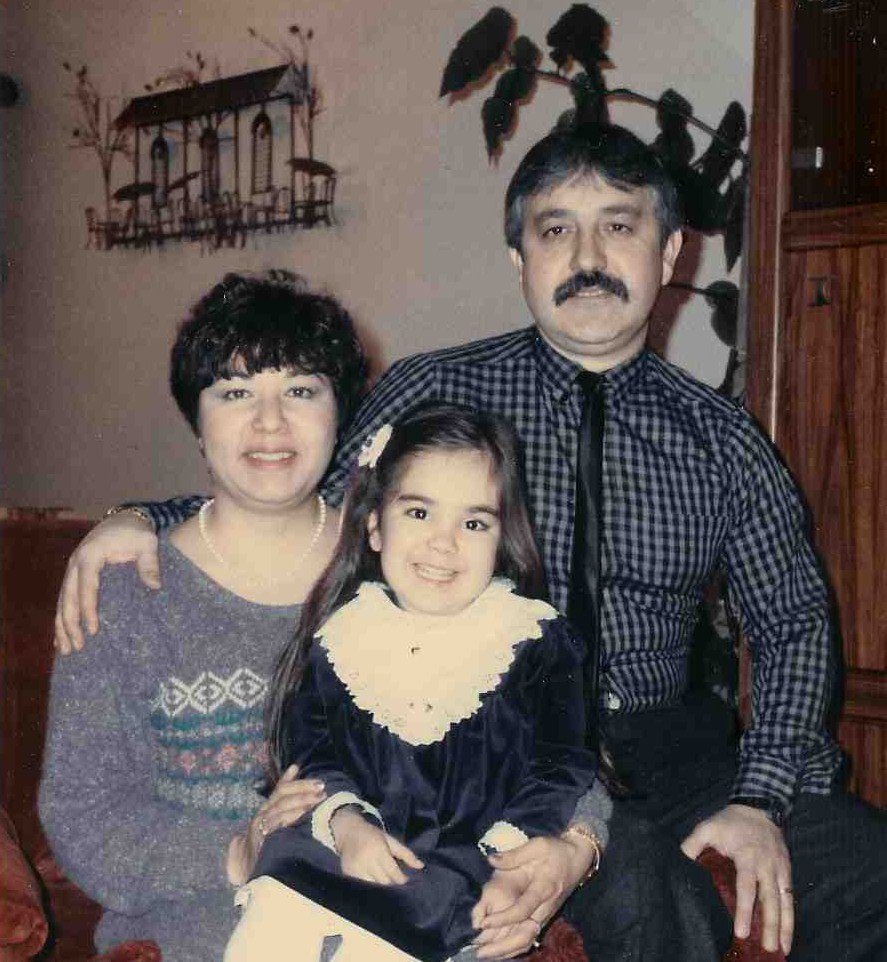
|
Lemis, Derya and Mubeyyin Altan, c. 1987 |
During my long and lonely struggle as a Crimean Tatar human rights advocate, I had very little support from my community or anyone else. Many times I felt guilty neglecting my family as I had to be away for weeks and even months leaving a young wife and child behind. There were times when I was very discouraged and asked myself why am I doing this. It was during those times that my Mom's inspirational advice and my wife Lemis' and my daughter Derya's supportive words helped me immensely continue fighting for my people's just cause. In fact, it was Derya who went to the director of a gallery in Concord, Massachusetts, and convinced him to have the first Crimean Tatar Exhibit of the original oil paintings of Seitxalil Osmanov depicting Surgun, the mass deportation. She was only twelve years old then. When I had trepidation to take two months off from my work in 1993 to travel to Ukraine and Crimea for research, it was Lemis who encouraged me to go. I am not only grateful to have these "Three Ladies" on my side who never stopped encouraging me, but also very lucky.
* The above interview was conducted by Inci A. Bowman. Mubeyyin B. Altan is currently Director of the Crimean Tatar Research and Information Center, New York, and a former President of the International Committee for Crimea (1999-2003).
Posted: 26 June 2011